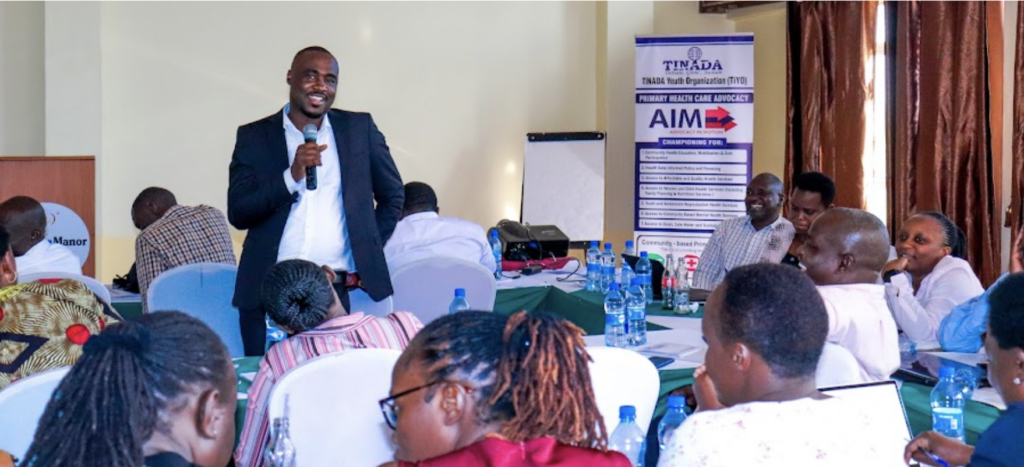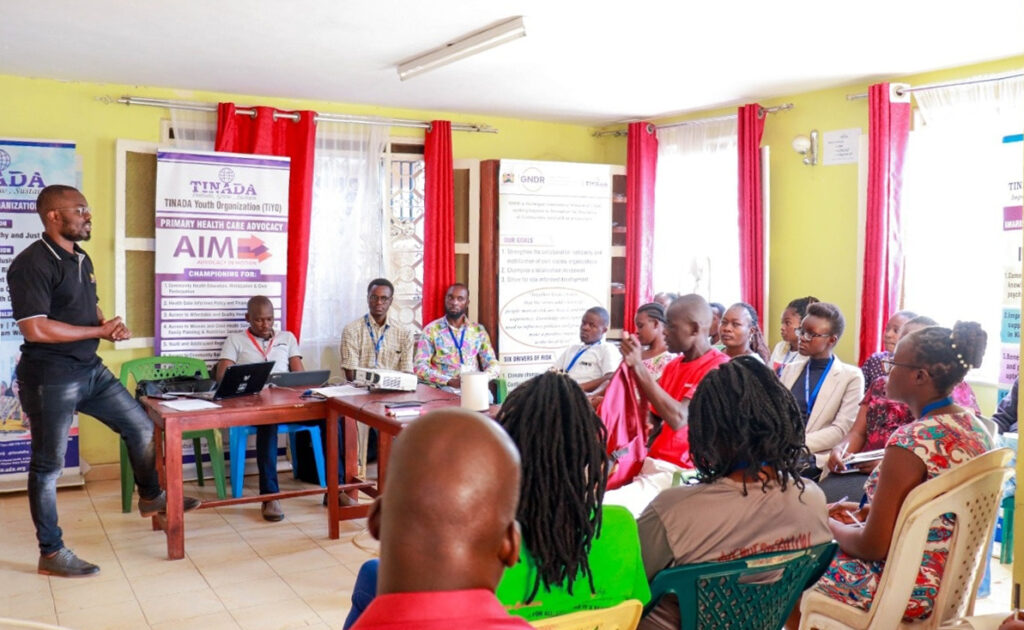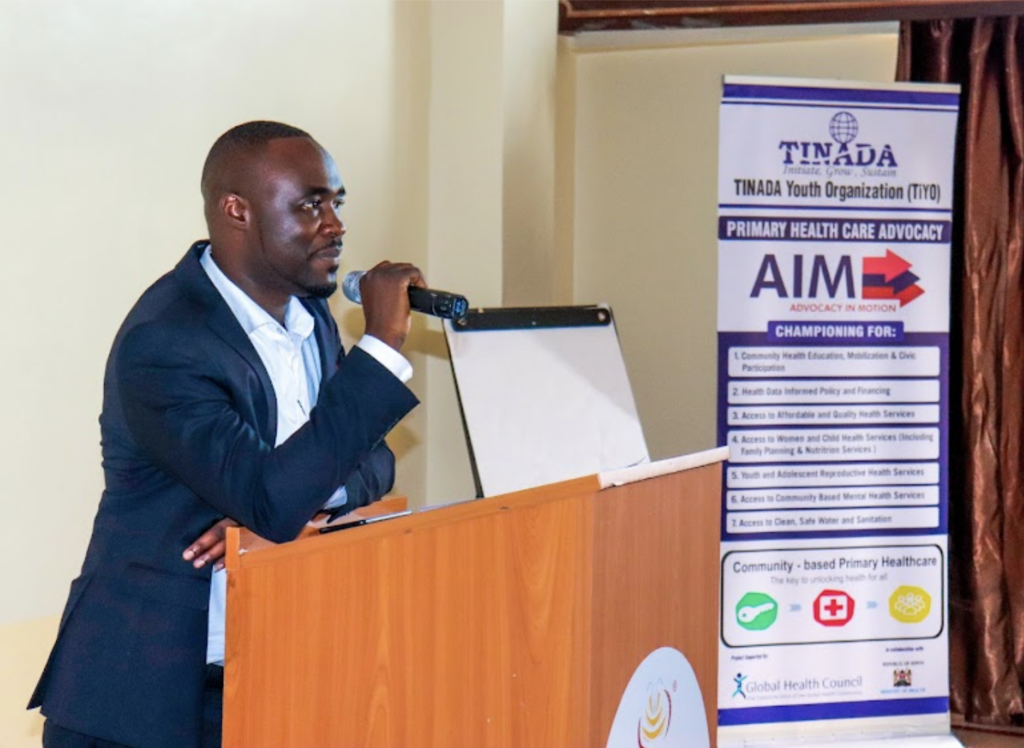Meet AIM Grant Recipient: TINADA Youth Organisation (TiYO)
Earlier this year, Global Health Council awarded its first-ever Advocacy in Motion (AIM) Grants to five civil society organizations. These grants are intended to support advocacy and health equity, as well as amplify the voices of local and regional organizations. This month we are featuring one of our winners, TINADA Youth Organization (TiYO).
Working in the Lake Victoria region of Kenya and Uganda, TINADA works to support teenage and single mothers, women, children, young people, and people with disabilities. We recently spoke with TINADA’s Executive Director, Roy Douglas Otieno, to learn more about the organization and its work.
Q: Can you tell us a bit about your organization?
TINADA is a youth-led, community-based organization (CBO) that began in 2001 as a youth group. In 2014, we registered as a CBO with Kenya’s Department of Social Services in order to scale and replicate our successful community empowerment programs within the Lake Victoria Region of Kenya and Uganda.
Today, TINADA is a youth and family-driven initiative that uses family-to-family and youth-to-youth interventions to demonstrate and attain sustainable community empowerment. Our areas of focus are integrated mental health, sexual and reproductive health and rights, education, economic empowerment, disability inclusion, human rights, and disaster risk reduction, especially within the Lake Victoria ecosystem. As a growing and local CBO, TINADA is committed to responding to community needs, challenges, and aspirations. Because community needs are diverse and resources are scarce, we seek out strategic partnerships with other stakeholders to achieve our goal of creating a more empowered, healthy, and just society.

Q: How has COVID impacted TINADA and the communities it serves?
COVID-19 momentarily threw all of us out of balance. Some of our team members fell ill during the peak of the pandemic. Government systems, as well as CBOs, were focused on how to manage the crisis. Our staff had to redirect part of their efforts to respond to the immediate needs of the community, which included mental health services. Responding to COVID-19 became the top priority for the government and civil society, sometimes to the detriment of other community needs.
The conversation on maternal and reproductive health stopped, and we saw a doubling of family planning gaps. The advocacy work TINADA had done in this area was lost. We had significantly less time for advocacy and community mobilization, which has historically been the bulk of our work. For a time, we had to stop our non-COVID advocacy work entirely.
Q: What is the biggest challenge your organization is facing today?
The health needs in the communities where we work are diverse and pressing, so we have been advocating for a stronger health system. However, in Kenya’s Homa Bay County, the alliances in place focus solely on funding specific areas of health. Without quality primary healthcare for everyone, we are seeing deepening social inequality among vulnerable populations, including poor health outcomes for children, women, youth, and low-income households. As our organization grows, we will need more core funding to respond to these challenges.
Presently, our most pressing need is for more staff and capacity to meet resource gaps surrounding primary healthcare. We also need to look into our strategies to ensure they align with our growth trajectory and that we achieve optimum return on investment. We would like to hire consultants and additional staff to help the organization during this phase of growth. To do that, we need greater visibility for our work to raise more resources.
Q: How are you hoping the AIM Grant will help your organization?
The AIM Grant has unlocked a door of opportunity by enabling us to look into our advocacy work. We are now developing the first primary healthcare (PHC) advocacy plan for the organization, which was not possible before due to a lack of the basic investment required. In subsequent years, the PHC advocacy plan will inform how we work with communities and other civil society organizations to improve access to quality healthcare in areas that matter to them. This investment is a game changer for our organization and the community we serve because access to quality healthcare improves overall health outcomes. This investment will influence the way many players are approaching specific diseases and health programs. The training and materials GHC offered have also been useful to us, and we still refer to them while doing advocacy work. Lastly, AIM has given our organization visibility that we hope will be helpful in resource mobilization.

Q: What does “health equity” mean to you?
Health equity means that health is a human right that is accessible to all, regardless of age, gender, or station in life. This implies that everyone should have an equal chance of enjoying the highest standards of physical, social, and mental well-being. Health equity also requires the protection of the environment where people live. In addition to being accessible and affordable, equitable healthcare should be provided in a way that upholds the dignity of the poorest and most vulnerable in society, as was the vision in the Alma-Ata declaration of 1978.

Q: What is the most important message you want to give to global health decision-makers?
Health is a basic need and also a human right, therefore it should not be reserved for people with the most resources. The afflicted may carry the cost of illness more personally, but it is a burden tothe whole globe. A poorly treated illness in the smallest village could easily become the next matter of global concern. Great investment must be made to enhance primary healthcare.
